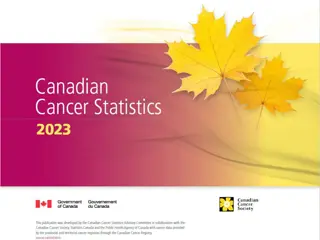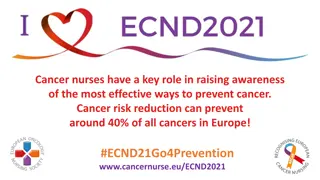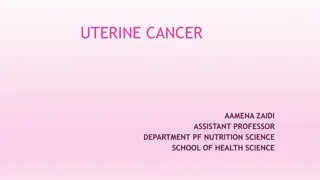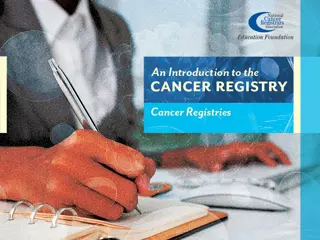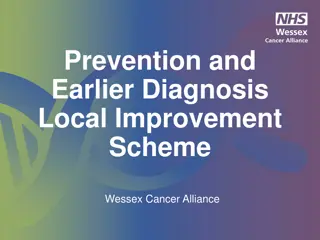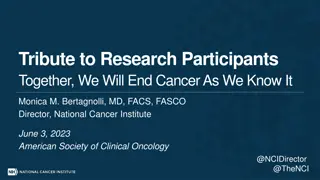Global Cancer Statistics and Trends
The data presented showcases global cancer statistics from various years, highlighting the prevalence of different types of cancer across genders. It includes information on the estimated number of cancer cases, common types of cancers, and trends expected up to 2035. Lung cancer, breast cancer, and colorectal cancer are among the most common types discussed. The visuals provided give a comprehensive overview of the worldwide cancer scenario and emphasize the importance of early understanding and tracking of disease development for effective management.
Download Presentation

Please find below an Image/Link to download the presentation.
The content on the website is provided AS IS for your information and personal use only. It may not be sold, licensed, or shared on other websites without obtaining consent from the author. Download presentation by click this link. If you encounter any issues during the download, it is possible that the publisher has removed the file from their server.
E N D
Presentation Transcript
. ( 2005 - 2014 ) - 84 - % 70 - . 5 1 . -
. % 45 - 2030 . 11 5 - 2030 2000 . 15 5 - ( 2025 - % 25 )
Worldwide data There were an estimated 14.1 million cancer cases around the world in 2012, of these 7.4 million cases were in men and 6.7 million in women. This number is expected to increase 24 Million by 2035
Both sexes Lung cancer was the most common cancer worldwide contributing 13% of the total number of new cases diagnosed in 2012. Breast cancer (women only) was the second most common cancer with nearly 1.7 million new cases in 2012. Colorectal cancer was the third most common cancer with nearly 1.4 million new cases in 2012 http://globocan.iarc.fr, accessed on 16/01/2015
Men Lung cancer was the most common cancer worldwide in men contributing nearly 17% of the total number of new cases diagnosed in 2012. The top three, lung, prostate and colorectal cancers, contributed nearly 42% of all cancers (excluding non-melanoma skin cancer). Other common cancers contributing more than 5% were stomach and liver http://globocan.iarc.fr, accessed on 16/01/2015
Women Breast cancer was the most common cancer worldwide in women contributing more than 25% of the total number of new cases diagnosed in 2012. The top three, breast, colorectal and lung cancers, contributed more than 43% of all cancers (excluding non-melanoma skin cancer). Cervical cancer also contributed nearly 8% of all cancers (excluding non-melanoma skin cancer).
If you would understand anything, observe its beginIf you would understand anything, observe its beginning and its development.
James watson&Francis crick 1962 DNA
DNA ) ( DNA 15
4-Aminobiphenyl Arsenic and arsenic compounds (Note: This evaluation applies to the group of compounds as a whole and not necessarily to all individual compounds within the group) Asbestos Azathioprine Benzene Benzidine Benzo[a]pyrene
Beryllium and beryllium compounds N,N-Bis(2-chloroethyl)-2-naphthylamine (Chlornaphazine) Bis(chloromethyl)ether and chloromethyl methyl ether (technical-grade) 1,3-Butadiene 1,4-Butanediol dimethanesulfonate (Busulphan; Myleran) Cadmium and cadmium compounds Chlorambucil 1-(2-Chloroethyl)-3-(4-methylcyclohexyl)-1-nitrosourea (Methyl-CCNU; Semustine) Chromium[VI] Ciclosporin
Cyclophosphamide Diethylstilbestrol Dyes metabolized to benzidine Epstein-Barr virus Erionite Estrogen-progestogen menopausal therapy (combined) Estrogen-progestogen oral contraceptives (combined) (Note: There is also convincing evidence in humans that these agents confer a protective effect against cancer in the endometrium and ovary)
Estrogens, steroidal (Note: This evaluation applies to the group of compounds as a whole and not necessarily to all individual compounds within the group) Estrogen therapy, postmenopausal Ethanol in alcoholic beverages Ethylene oxide Etoposide in combination with cisplatin and bleomycin Formaldehyde Gallium arsenide [Gamma Radiation: see X- and Gamma (g)-Radiation] Helicobacter pylori (infection with) Hepatitis B virus (chronic infection with) Hepatitis C virus (chronic infection with) Human immunodeficiency virus type 1 (infection with)
Human papillomavirus types 16, 18, 31, 33, 35, 39, 45, 51, 52, 56, 58, 59 and 66 (Note: The HPV types that have been classified as carcinogenic to humans can differ by an order of magnitude in risk for cervical cancer) Human T-cell lymphotropic virus type I Melphalan 8-Methoxypsoralen (Methoxsalen) plus ultraviolet A radiation Methylenebis(chloroaniline) (MOCA) MOPP and other combined chemotherapy including alkylating agents Mustard gas (Sulfur mustard) 2-Naphthylamine Neutrons Nickel compounds
butanone (NNK) Opisthorchis viverrini (infection with) [Oral contraceptives, combined estrogen-progestogen: see Estrogen-progestogen oral contraceptives (combined)] Oral contraceptives, sequential Phosphorus-32, as phosphate Plutonium-239 and its decay products (may contain plutonium-240 and other isotopes), as aerosols Radioiodines, short-lived isotopes, including iodine-131, from atomic reactor accidents and nuclear weapons detonation (exposure during childhood) Radionuclides, a-particle-emitting, internally deposited (Note: Specific radionuclides for which there is sufficient evidence for carcinogenicity to humans are also listed individually as Group 1 agents)
Radionuclides, b-particle-emitting, internally deposited (Note: Specific radionuclides for which there is sufficient evidence for carcinogenicity to humans are also listed individually as Group 1 agents Radium-224 and its decay products Radium-226 and its decay products Radium-228 and its decay products Radon-222 and its decay products Schistosoma haematobium (infection with) Silica, crystalline (inhaled in the form of quartz or cristobalite from occupational sources) Solar radiation
Talc containing asbestiform fibres Tamoxifen (Note: There is also conclusive evidence that tamoxifen reduces the risk of contralateral breast cancer) 2,3,7,8-Tetrachlorodibenzo-para-dioxin Thiotepa Thorium-232 and its decay products, administered intravenously as a colloidal dispersion of thorium-232 dioxide ortho-Toluidine Treosulfan Vinyl chloride
X- and Gamma (g)-radiation Mixtures Aflatoxins (naturally occurring mixtures of) Alcoholic beverages Areca nut Betel quid with tobacco Coal-tar pitches Coal-tars
Herbal remedies containing plant species of the genus Aristolochia Household combustion of coal, indoor emissions from Mineral oils, untreated and mildly treated Phenacetin, analgesic mixtures containing Salted fish (Chinese-style) Shale-oils Soots Tobacco, smokeless Wood dust
Exposure circumstances Aluminum production Arsenic in drinking-water Auramine production Boot and shoe manufacture and repair Chimney sweeping Coal gasification Coal-tar distillation Coke production
Furniture and cabinet making Hematite mining (underground) with exposure to radon Involuntary smoking (exposure to secondhand or 'environmental' tobacco smoke) Iron and steel founding Isopropyl alcohol manufacture (strong-acid process) Magenta production Painter (occupational exposure as a) Paving and roofing with coal-tar pitch Rubber industry Strong-inorganic-acid mists containing sulfuric acid (occupational exposure to) Tobacco smoking and tobacco smoke
tobacco use being overweight or obese low fruit and vegetable intake physical inactivity alcohol use Sexually transmitted HPV-infection urban air pollution indoor smoke from household use of solid fuels
Lifestyle factors, including diet, have long been recognised as potentially important determinants of cancer risk 35% of cancer deaths might be avoidable by changes in diet and tackling obesity. dietary habits and cancer incidence and mortality and the large global variations in cancer incidence and mortality rates, along with rapid changes in cancer rates among migrant populations . Cancer Epidemiology
Ecological studies showing significant correlations between dietary habits and cancer incidence and mortality.
2007 World Cancer Research Fund American Institute for Cancer Research Personal Recommendations for Cancer Prevention : Recommendations
Body fatness Be as lean as possible within the normal range of body weight Personal recommendations -Ensure that body weight throughout childhood and adolescent growth projects towards the lower end of the normal BMI range at age 21. Maintain body weight within the normal range from age 21. Avoid weight gain and increases in waist circumference throughout adulthood
Physical activity Be physically active as part of everyday life Personal recommendations Be moderately physically active, equivalent to brisk walking, for at least 30 min every day As fitness improves, aim for 60 min of moderate or 30 min of vigorous physical activity every day Limit sedentary habits such as watching television
Foods and drinks that promote weight gain Limit consumption of energy-dense foods and avoid sugary drinks Personal recommendations Consume energy-dense foods sparingly Avoid sugary drinks Consume fast foods sparingly, if at all






